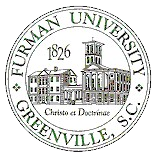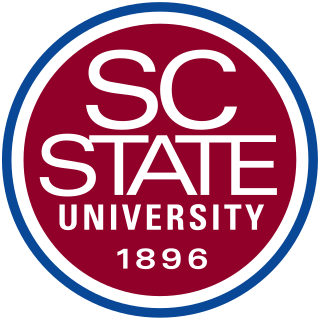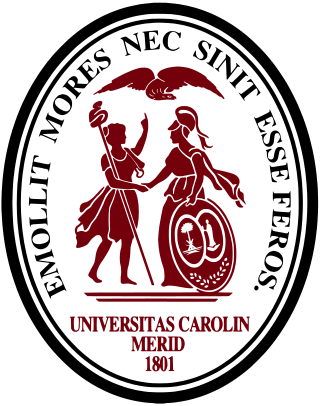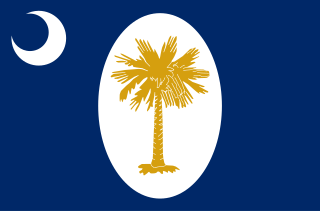
South Carolina is a state in the coastal Southeastern region of the United States. It borders North Carolina to the north, the Atlantic Ocean to the southeast, and Georgia to the southwest across the Savannah River. Along with North Carolina, it makes up the Carolinas region of the East Coast. South Carolina is the 40th-largest and 23rd-most populous U.S. state with a recorded population of 5,118,425 according to the 2020 census. In 2019, its GDP was $213.45 billion. South Carolina is composed of 46 counties. The capital is Columbia with a population of 136,632 in 2020; while its most populous city is Charleston with a 2020 population of 150,227. The Greenville-Spartanburg-Anderson, SC Combined Statistical Area is the most populous combined metropolitan area in the state, with an estimated 2023 population of 1,590,636.

The 1796 United States presidential election was the third quadrennial presidential election of the United States. It was held from Friday, November 4 to Wednesday, December 7, 1796. It was the first contested American presidential election, the first presidential election in which political parties played a dominant role, and the only presidential election in which a president and vice president were elected from opposing tickets. Incumbent vice president John Adams of the Federalist Party defeated former secretary of state Thomas Jefferson of the Democratic-Republican Party.

James Strom Thurmond Sr. was an American politician who represented South Carolina in the United States Senate from 1954 to 2003. Before his 48 years as a senator, he served as the 103rd governor of South Carolina from 1947 to 1951. Thurmond was a member of the Democratic Party until 1964 when he joined the Republican Party for the remainder of his legislative career. He also ran for president in 1948 as the Dixiecrat candidate, receiving over a million votes and winning four states.

The University of North Carolina at Chapel Hill is a public research university in Chapel Hill, North Carolina. Chartered in 1789, the university first began enrolling students in 1795, making it one of the oldest public universities in the United States.

Clemson University is a public land-grant research university in Clemson, South Carolina. Founded in 1889, Clemson is the second-largest university by enrollment in South Carolina. For the fall 2023 semester, the university enrolled a total of 22,875 undergraduate students and 5,872 graduate students, and the student/faculty ratio was 15:1.

The Southern United States, sometimes Dixie, also referred to as the Southern States, the American South, the Southland, Dixieland, or simply the South, is a geographic and cultural region of the United States of America. It is between the Atlantic Ocean and the Western United States, with the Midwestern and Northeastern United States to its north and the Gulf of Mexico and Mexico to its south.

James Francis Byrnes was an American judge and politician from South Carolina. A member of the Democratic Party, he served in the U.S. Congress and on the U.S. Supreme Court, as well as in the executive branch, most prominently as the 49th U.S. Secretary of State under President Harry S. Truman. Byrnes was also the 104th governor of South Carolina, making him one of the very few politicians to have served in the highest levels of all three branches of the American federal government while also being active in state government.

Furman University is a private liberal arts university in Greenville, South Carolina. Founded in 1826 and named after Baptist pastor Richard Furman, Furman University is the oldest private institution of higher learning in South Carolina. It became a secular university in 1992, while keeping Christo et Doctrinae as its motto. As of Fall 2021, it enrolls approximately 2,300 undergraduate students and 150 graduate students on its 750-acre (304 ha) campus.

South Carolina State University is a public, historically black, land-grant university in Orangeburg, South Carolina. It is the only public, historically black land-grant institution in South Carolina, is a member-school of the Thurgood Marshall College Fund, and is accredited by the Southern Association of Colleges and Schools (SACS).

Hugh Swinton Legaré was an American lawyer, diplomat and politician from South Carolina who served as the 16th United States Attorney General under President John Tyler.

The University of South Carolina is a public research university in Columbia, South Carolina. It is the flagship of the University of South Carolina System and the largest university in the state by enrollment. Its main campus is on over 359 acres (145 ha) in downtown Columbia, close to the South Carolina State House. The university is classified among "R1: Doctoral Universities with Highest Research Activity". It houses the largest collection of Robert Burns and Scottish literature materials outside Scotland and the world's largest Ernest Hemingway collection.

Carroll Ashmore Campbell, Jr., was an American Republican politician who served as the 112th governor of South Carolina from 1987 to 1995. Before this, he served as a member of the South Carolina Senate representing the 2nd district from 1977 to 1978 and as a congressman representing South Carolina's 4th district from 1979 to 1987.

The South Carolina Declaration of Secession, formally known as the Declaration of the Immediate Causes Which Induce and Justify the Secession of South Carolina from the Federal Union, was a proclamation issued on December 24, 1860, by the government of South Carolina to explain its reasons for seceding from the United States. It followed the brief Ordinance of Secession that had been issued on December 20. The declaration is a product of a convention organized by the state's government in the month following the election of Abraham Lincoln as U.S. president, where it was drafted in a committee headed by Christopher Memminger.

South Carolina was the first state to secede from the Union in December 1860, and was one of the founding member states of the Confederacy in February 1861. The bombardment of the beleaguered U.S. garrison at Fort Sumter in Charleston Harbor on April 12, 1861, is generally recognized as the first military engagement of the war. The retaking of Charleston in February 1865, and raising the flag again at Fort Sumter, was used for the Union symbol of victory.

The 1958 South Carolina gubernatorial election was held on November 4, 1958 to select the governor of the state of South Carolina. Ernest Hollings won the Democratic primary against rival Donald S. Russell and ran unopposed in the general election becoming the 106th governor.

The lieutenant governor of South Carolina is the second-in-command to the governor of South Carolina. Beyond the responsibility to act or serve as governor in the event of the office's vacancy, the duties of the lieutenant governor are chiefly ceremonial. The current lieutenant governor is Pamela Evette, who took office January 9, 2019.

William Bullein Johnson was an American Baptist minister, one of the founders of the South Carolina State Baptist Convention in 1821, and later was the first president of the Southern Baptist Convention from 1845 to 1851. Johnson is also the founder of Johnson Female Seminary, later renamed Johnson University, in 1848, the predecessor to Anderson University.
Peter Skewes is an American university professor and political activist best known for his candidacy for president of the United States as the nominee of the American Party of South Carolina in the 2016 presidential election.

The 1956 United States presidential election in South Carolina took place on November 6, 1956, as part of the 1956 United States presidential election. South Carolina voters chose eight representatives, or electors, to the Electoral College, who voted for president and vice president.

The 1912 United States presidential election in North Carolina took place on November 5, 1912, as part of the 1912 United States presidential election. North Carolina voters chose 12 representatives, or electors, to the Electoral College, who voted for president and vice president. Like all former Confederate states, North Carolina would during its “Redemption” develop a politics based upon Jim Crow laws, disfranchisement of its African-American population and dominance of the Democratic Party. However, unlike the Deep South, the Republican Party possessed sufficient historic Unionist white support from the mountains and northwestern Piedmont to gain a stable one-third of the statewide vote total in general elections even after blacks lost the right to vote.







































